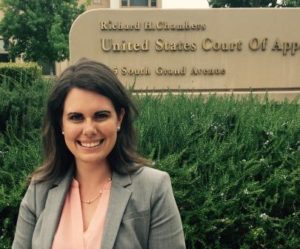The Religious Liberty Clinic: A Day in the Life
With pleasure, we welcome SLS student Kimberly Larkin (JD ’16) to the MLC blog. Continuing our Day-in-the-Life series, Kimberly shares what one day was like for her as a student attorney in the Religious Liberty Clinic last winter quarter.
8:45 a.m. – I arrive at clinic, coffee in hand. My colleagues and I check email and catch up about our cases. Our docket includes Seventh-day Adventists wanting to abstain from Saturday work without losing their jobs; a Messianic Jewish inmate seeking a kosher meal; and a Muslim community fighting to secure a permit for a mosque.
9:15 a.m. – My partner in one of my cases flags new authority from another court that supports our client’s position. We discuss the new authority with our director and decide to file a short letter alerting the court in our case to it. My partner and I dissect the legal points, assign section drafts, and set a call with the client for later today. Respecting client ownership of the case, we struggle with whether to ask the client now for approval to file the letter. We ultimately decide to send a draft first so that the client can make an informed decision.
10:15 a.m. – On another case, my partner and I field an urgent call from a client worried about the non-legal consequences of proceeding with a lawsuit. We listen and validate the client’s concerns but suggest it might be best to meet in person to discuss further and resolve the dilemma in a manner consistent with the client’s goals. We set an in-person meeting for later in the week. The client is grateful, and we are relieved to be on the same page.
11:00 a.m. – I draft my section of the case update letter, drawing upon the new authority and other relevant case law. My partner and I combine our sections into a draft letter and submit it to our faculty director for review and a joint editing session this afternoon.
12:45 p.m. – While waiting for feedback, I grab lunch from one of the many Stanford food trucks with a friend and take a moment to enjoy the beautiful California weather.
1:30 p.m. – My partner and I join our director to workshop the letter. We put the draft on a projector and discuss line edits, honing our analysis and word choice to make sure we represent the new authority accurately and persuasively. We are mindful of the court’s rules for a short, non-argumentative letter. While watching favorite phrases morph and change through group editing can be painstaking and humbling, the final product is strong and effective.
3:45 p.m. – My partner and I email the draft letter to our client and take a coffee break to recharge before our call.
4:15 p.m. – My partner and I call our client to discuss the letter. We review the draft, answer questions, and solicit changes. The client likes the draft a lot but asks us to include a discussion of further harm that has occurred since the last time we appeared in court. We share in the client’s frustration but explain the court’s rules on the limited, informational purpose of the case-update letter. The client is pleased and authorizes us to file the letter.
5:00 p.m. – My partner and I work together to finalize the letter to the court, incorporating the minor changes requested by our client. With the help of clinic staff, we e-file the letter. We then reflect on today’s work with our director.
6:00 p.m. – I leave the clinic and head for home. I’m a bit tired but pleased to have done critical, hands-on legal work for real clients in dynamic situations.

